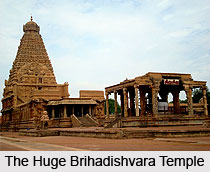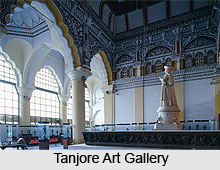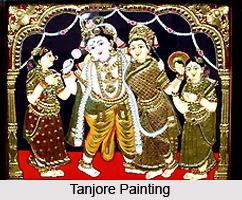 Tanjavur or Tanjore is a splendid old town of Tamil Nadu. The region had been the capital city of many rulers during pre-independence period. Tanjavur was the region was very fertile for agriculture, with many rivers and canals in the neighbourhood. The lush green paddy fields, coconut groves, jackfruit orchards and banana plantations make it one of the very attractive places of Tamil Nadu. Tanjavur is regarded as the rice bowl of Tamil Nadu.
Tanjavur or Tanjore is a splendid old town of Tamil Nadu. The region had been the capital city of many rulers during pre-independence period. Tanjavur was the region was very fertile for agriculture, with many rivers and canals in the neighbourhood. The lush green paddy fields, coconut groves, jackfruit orchards and banana plantations make it one of the very attractive places of Tamil Nadu. Tanjavur is regarded as the rice bowl of Tamil Nadu.
Tanjavur town was the royal capital for over 1000 years from the 9th to the 19th centuries. The huge Brihadishvara temple built by Rajaraja I and the great Chola monarch of the early 10th century A.D are also situated in Tanjavur. The vimana or the tower above the temple consists of thirteen storeys and is over 60m high. There is a dome above this tower, which weighs over 80 tonnes. Some of the walls of the temple are covered with beautiful paintings.
The Tanjavur town also has a number of smaller temples, tanks and a large medieval palace, which were built by the Nayak and Maratha kings who ruled Tanjavur after the Cholas. The miniature paintings and cut-glass handicraft items of the town is unique to this place.
The Cholas succeeded the Pallavas in Tamil Nadu and they were great patrons of art. During their time, many temples were constructed in Tanjavur and a number of titsavetmurtisor processional deities were fashioned to meet the needs of these temples.
The figures of these deities were made more formal in pose and moulding than in the Pallava period. The early period of Pallava rule had gracefully bent body of the deities. The sacred thread (yagno-pavita) became rather lean compared to the ribbon-like ones of the Pallava period and the upper arm starting from the shoulder rather than from the elbow of the lower arm as in the Pallava period.
The Tirupurantaka (Siva) sculpture of 64 cms height is one of the earliest of the Chola bronzes of Tanjavur. From the available details, it is assumed to be designed in the middle of the 9th century. It is an early bronze of Saivite themes so it bears ancient style.
 The Natesa (Siva as the dancer) from Kuram here is 53 cms in height and describes the development in all its glory in a concise and dazzling manner. It is therefore considered to be a masterpiece and a gem of a bronze. In the Tanjore Art Gallery of Tanjavur, one can see the Vishapaharana (one who takes away the poison) from Kilapundannur and the Vinadharamurthi (one who carries the veena). Here, the bronze representing Siva in a seated pose is almost similar to the Vinadharamurthi and it seems to have formed a Somaskanda (Siva with Parvati and Muruga) or Uma Sahita (Siva with Parvati) group. Few other significant bronze sculptures of Tanjavur include those of Rama, Sita, Lakshmana and Hanuman from Vadakkapannaiyur, Srinivasa with Sridevi and Bhudevi from Sirupanaiyur, the Buddha from the temple of Manjunatha at Kadri near Mangalore, and the Bikshatanamurthi (mendicant) from Tirunamanallur, Ganesa from Settipulam, the Chandikeswara from Okkur, Maheswari from Velankanni, Natesa from Sivapuram and the seated Buddha from Nagapattinam and many more. Their construction age is assumed from their characteristic styles, physiognomic features, ornamentation and the icons and epigraphy on the pedestal.
The Natesa (Siva as the dancer) from Kuram here is 53 cms in height and describes the development in all its glory in a concise and dazzling manner. It is therefore considered to be a masterpiece and a gem of a bronze. In the Tanjore Art Gallery of Tanjavur, one can see the Vishapaharana (one who takes away the poison) from Kilapundannur and the Vinadharamurthi (one who carries the veena). Here, the bronze representing Siva in a seated pose is almost similar to the Vinadharamurthi and it seems to have formed a Somaskanda (Siva with Parvati and Muruga) or Uma Sahita (Siva with Parvati) group. Few other significant bronze sculptures of Tanjavur include those of Rama, Sita, Lakshmana and Hanuman from Vadakkapannaiyur, Srinivasa with Sridevi and Bhudevi from Sirupanaiyur, the Buddha from the temple of Manjunatha at Kadri near Mangalore, and the Bikshatanamurthi (mendicant) from Tirunamanallur, Ganesa from Settipulam, the Chandikeswara from Okkur, Maheswari from Velankanni, Natesa from Sivapuram and the seated Buddha from Nagapattinam and many more. Their construction age is assumed from their characteristic styles, physiognomic features, ornamentation and the icons and epigraphy on the pedestal.
During the later period of Chola kingdom, the emblems of these images were held on two upraised fingers and the headdress is conical, the sacred thread consists of three strands of equal thinness and the necklace is elaborate. The earliest bronze of the later Chola period (1100-1350) is the Somaskanda from Nidur. Some other bronze sculptures of Tanjavur belonging to Chola period include the Avalokiteswara (Bodhisatva) from Nagapattinam, Parvati from the same place, Pradoshamurthi (Siva) from Vellagaram, Parvati or Sivakamasundari from Sivapuram and the Rama group from Tirukkadaiyur. The most popular icon of Tamil Nadu is the Nataraja or the dancing form of Siva from Tanjavur. The central motif of this dance represents the five cosmic activities of creation, evolution, preservation, destruction, illusion and salvation. The fourth hand is pointing to his lifted foot, the refuge of the soul. One foot is resting on Apasmara, the embodiment of human cruelty and ignorance.
 An immense aureole of flames is shown radiating from the Siva`s figure, which represents the vital processes of nature, sustained by the fabulous energy of the dancing God within. These flames symbolise the transcendental power of wisdom and truth, as well as the mantra `OM` which signifies the totality of creation.
An immense aureole of flames is shown radiating from the Siva`s figure, which represents the vital processes of nature, sustained by the fabulous energy of the dancing God within. These flames symbolise the transcendental power of wisdom and truth, as well as the mantra `OM` which signifies the totality of creation.
One of the best examples of `Ardhanarisvara` is the one from Tiruvengadu of the Tanjavur district. It can be now seen at the Madras Museum. Ardhanariswara, as the name itself suggests, shows Siva as half male and half-female, illustrating both the male and the female energies. During, the later part of Pandya period, some bronze figures of a Jaina Thirthankara and few others were brought in Tanjavur. These include those from somewhere near Sivaganga, the seated Vishnu from Sermadevi, Umasahita from Tanjavur district itself and the standing Mahavira from Singanikuppam



















